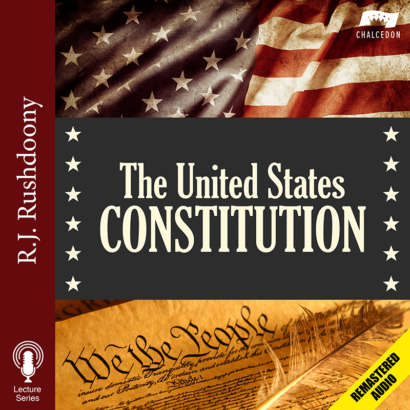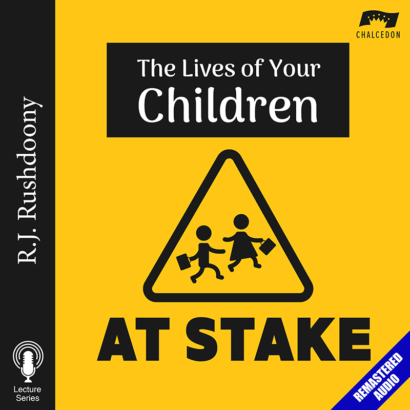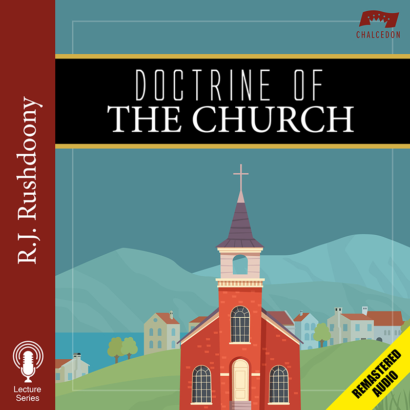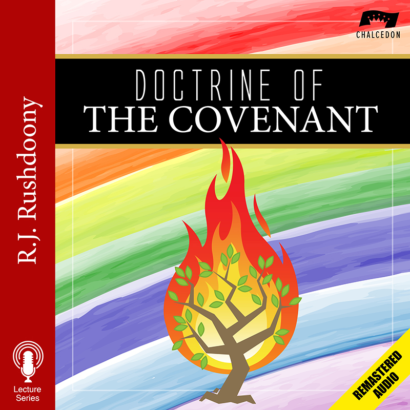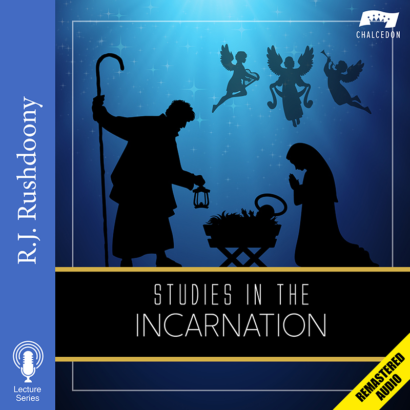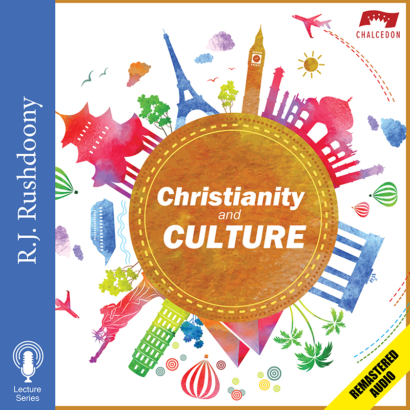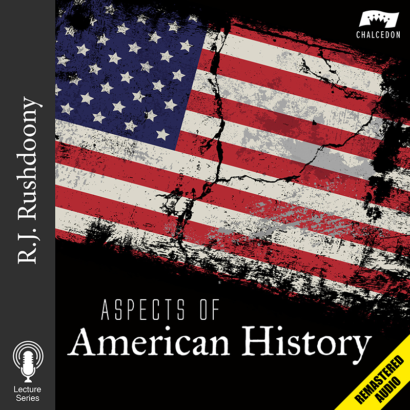4. Ancient History and Christianity: Part I (Remastered)
R.J. Rushdoony • Sep, 03 2024
- Series: A Christian Survey of World History (Remastered)
- Topics:
Ancient History and Christianity: Part I
R.J. Rushdoony
Our subject history, is something very modern. It has to do with a Scotch recipe. Now, I think this recipe will be amusing to hear about. I am not saying this to poke fun at the Scotch, as you will see when I am finished, because after all, being married to a Scotch girl, it would hardly be very wise for me to ridicule the Scots, and besides I think they are pretty wonderful and remarkable people. But there is a point in this with regard to history.
This is the recipe for the very popular Scotch dish which has often been called the national dish, Haggis. Haggis is something perhaps you have never heard about. After you hear about it, you may be glad you never did! Now, this recipe is in an English encyclopedia of gastronomy, so written by a Frenchman in England, so you can see they are not going to be particularly congenial to something from up North in Scotland, so I will read.
“‘HAGGIS A popular Scots dish, named by Burns Great chieftain O' the puddin’ race. It is made of the heart, lungs, and liver of the sheep, hashed or finely-minced (about a quarter of the liver being grated), with suet, onions, oatmeal, salt and pepper. The whole is usually sewn up in either the large stomach bag, or a smaller one called the ‘king’s hood’, of the sheep, well cleansed.—L.G.M.
…
As a rule one does not attempt to make a haggis; one just buys a haggis and does not inquire too closely as to how it was made. A bought haggis must be simmered in all-but boiling water long enough to be thoroughly hot and steaming when a slit is made in the paunch for a large tablespoon (previously dipped in boiling water) to be inserted and the haggis scooped out. It is usually served wrapped up in a stiffly-starched napkin to cover the none too appetizing bare looks of the sheep’s stomach, Neat whisky is the orthodox liquid accompaniment of the haggis, and it should be drunk from a Quaich, a kind of shallow wooden drinking cup with two lugs or handles.
Edward Spencer… tells in ‘Cakes and Ale’ how haggis was introduced into Scotland by the Romans, who made it by filling a pig’s boiled stomach with fry and brains, raw eggs and pulped pineapples, seasoned with a disgusting decoction called liguamen, based on putrefied intestines of fish mixed with spices and wine; but the Scots, who hated any form of pig [Let me add, parenthetically, because they took the Old Testament kosher laws very strictly. The Scots, therefore, wouldn’t have anything to do with anything that was not kosher - RJR], …and this being so, it is rather surprising that old English classical authors, such as Mesdames Glasse and Mason, modify their Scotch Haggis or Hagas by the use of calf. Here, however, is the official recipe taught in the schools of Edinburgh at the present day, which appears to embody most of the principles necessary for success with the age-old Scottish favourite.
Haggis
A sheep’s bag and pluck, liver and heart, a half ounce minced suet, a half pound of oatmeal, a half teaspoon powdered herb, ½ ditto salt, ½ ditto pepper, 4 medium sized onions.
Wash the bag in cold water, scrape and clean it well, let it lie all night in cold water with a little salt; wash the pluck, put it into a pot of boiling water.
Wash the bag in cold water, scrape and clean it well, let it lie all night in cold water with a little salt; wash the pluck, put it into a pot of boiling water with a teaspoon of salt, Boil for two hours with the windpipe hanging out; when cold cut off the windpipe, grate half the liver, the other half of which is not used, mince the heart, lights, suet and onions, add the oatmeal (which should first be toasted to a golden colour), the pepper and salt and herbs and one pint of the water the pluck was boiled in. Mix well, fill the bag rather more than half full of the mixture, sew it up. Place the haggis in a pot of boiling water, and boil for three hours, pricking it occasionally to keep it from bursting. Serve very hot with mashed potatoes and turnips and of course a quaich [that’s the wooden bowl with whisky - RJR] if desired.
It has been recently stated that this creature ‘can be used whole and uncut, to boil with a thick vegetable and water stew, making a nutritious soup. It can then be cut open, and eaten either as a vegetable or as the meat course. What is left is cut in slices and fried instead of bacon for breakfast, and the remains put in pastry cases make useful savouries. The case which holds it is tripe, so every bit (but the string) is edible.’” 1
That is the national dish. And I read about it at some length because I think it has a great deal of relevance to the study of history. You can go across the face of the earth and find that in bygone years, when food was scarce and times were difficult, other people had similar dishes. They forgot about them the minute they prospered, but it is still the national dish in Scotland. And it has something to do of course, with the character. There is nothing wasted, you see, of the sheep when they butcher it, everything is used, except the string with which the thing was sewed up.
Now, of course, this goes back to character. After all, a Scotch proverb is, that you need salt with porridge. In other words, you don’t put sugar in your porridge, that spoils a person, it makes them soft. You put salt in your porridge. So adversity is something they like, and luxury, such as sugar, is something they dislike.
To cite another thing which will perhaps might not strike some of you in the best of taste, but I think is very revealing about the Scotch. In the islands of Scotland to this day they regard it as a mark of being soft and effeminate, a weak English type of character, if you have a wee hoosty in back of the cottage. A wee hoosty is an outhouse. Any vigorous Scot takes a two mile walk out into the heather! And this is their way of life. Of course, the saying is that during World War I, the reason why the Scottish Black Watch was such a terror to the Germans was that they were always looking for that two miles of open country when they charged over the top.
Well, I’ve taken a little time to go into this about the Scotch because what does it all reveal? There are people who today are prosperous, but they still have the same national dish, they still have ways that mark them all over the world. Anthropologists have said that the two people who have gone into more areas of the world carrying civilization are the Scotch and the Jews. And there is almost no point in the world where you travel where you don’t find that the Scotch and the Jews have gone in and contributed to civilization, even the outposts of civilization. And of course, if you go back to the history of America, you find that most of your schools and colleges were started by Scotchmen, a very interesting fact.
Now, other people have had dishes like Haggis in hard times, but why has the Scotch had it in any kind of time? It goes back to something in the national character which was there very early when Christianity came in, and became doubly-reinforced when they became Calvinistic or Presbyterian. In other words, history is not just environment. Many people have had difficult environments, the Scotch are not alone, it is also character, and behind the character is their faith.
Now, we are going to begin with a people who had a marked character in history, the Assyrians. An amazing and terrifying people. They were never numerically strong. They were a small handful of people. And yet, they dominated the world for centuries. They first rose to power, oh, about a couple of centuries before David and Solomon. There was a period there during the reigns of David and Solomon when their power more or less waned for a brief time, but then it arose again immediately after Solomon’s time, and it continued for several centuries after. They were a terrifying people, warlike to the nth degree, given to terrorizing people.
Now in our text I described some of their practices. You can go through the inscriptions these Assyrian monarchs left and also the records of other people, and you find why they were a terror to the people of their day. If a people would not submit immediately when they would tell them, “Submit to our power and become a tributary people or else” They would go in and raze their cities to the ground, they would behead the men one after another, and leave a mountain of skulls, a mountain of skulls, thousands and tens of thousands of skulls. And they would take the leaders, the king and his counselors and others, and skin them alive before they executed them. It is no wonder that they became a byword for terror. This was their way. It was an aspect of their national character.
Now, there still are some Assyrians, fifty to a hundred thousand at most, that is all. They have been for now for centuries a Christian people, and they are very mild, kindly people. Their previous faith made them a particularly war like and ugly people. Now, they are a particularly kindly and superior people. There are a few colonies of them in California, they have a church or two in the San Jouaquin Valley, I believe, there is or there used to be a church, an Assyrian Presbyterian church in Turlock and one or two in adjacent areas.
The Assyrians, thus, a very powerful people, but numerically very small, dominated the world for a long time, both because of their character, and also because of their terror. But their character, their discipline was enormous. And their military discipline made them something to reckon with wherever they went because it took only a very limited number of Assyrians against the enemy to overthrow them.
Let us turn now to the religious side of the Assyrians. Turning to one of their ancient inscriptions from Pritchard’s Ancient Near Eastern Texts, we have the statement of one of their monarchs, from Shalmaneser III whose dates are 858-824 B.C.:
“(I am) Shalmaneser, the legitimate king, the king of the world, the king without rival, the ‘Great Dragon,’ the (only) power within the (four) rims (of the earth), overlord of all the princes, who has smashed all his enemies as if (they be) earthenware, the strong man, unsparing, who shows no mercy in battle…” 2
Now, that is how he identifies himself, as the merciless one. But also the king of the world, the king without rival, the great dragon. And the footnote makes it clear that the meaning of this, ‘ušumgal,’ means giant snake. This is a very interesting thing. And of course, it doesn’t take more than a moment’s reflection to understand the significance of that. After all, what is Satan called over and over again in Scripture? And even in Revelation, Revelation 12:9 we have this designation at the very end of Scripture:
“And the great dragon was cast out, that old serpent, called the Devil, and Satan, which deceiveth the whole world…”
Very clearly, you see, the Assyrian monarchs in calling themselves ‘the great dragon,’ saw themselves as the incarnation as it were, as the presence in the world of Satan. But not Satan as we see him, as the enemy, but as the great liberator of mankind.
Let us turn over to another inscription from Ancient Assyria. This is from Adad-Nirari III whose dates are 810-783 B.C..
“Adad-nirari, great king, legitimate king, king of the world, king of Assyria—a king whom Ashur, the king of the Igigi (i.e. the dei superi [that is, the superior god among gods- RJR]) had chosen (already) when he was a youngster, entrusting him with the position of a prince without rival, (a king) whose shepherding they made as agreeable to the people of Assyria as (is the smell of) the Plant of Life, (a king) whose throne they established firmly….” 3
He called himself thus, the shepherd of Assyria.
Now the word ‘shepherd’ in ancient times meant God. God is the shepherd of men. And this is why God speaks of Himself as the shepherd of Israel in the Old Testament. And when our Lord said: “I am the good shepherd, and I know my sheep.” He was saying: “I am God.” This is why they said: “He makes himself to be God.” What did Adadi-nirari call himself? The great God, who is like the plant of life, or the tree of life. Now, do you see something of the faith behind Assyria and its character?
The bringer of life to mankind, the liberator of man; Satan. The kings of Assyria as the great Dragon, the liberator, the bringer of life and freedom to men. Like the tree of life or the plant of life. In other words, pagan religions were satanic imitations of true religion, whose design was to lead to the kingdom or city of man, as against the city of God. To regain Eden by means of conquest, and change and chaos were seen as the way to progress and freedom.
The kings, therefore, as the representatives of the great serpent were waging a revolution against ‘God, the tyrant;’ and using chaos as a way to order without God. I pointed out in the text how they saw the world as the evolving world order, and the king or ruler who was at the top at any one point, would be for the time the representation, the manifestation of the power of the universe, the great dragon. And for this purpose everything was to be brought under him as the liberator of mankind. And this is why the Assyrians, who had a dream of a one world without God, would take people forcibly out of their homeland and scatter them throughout their empire, so that they would break down all national allegiances.
And this is what they did to the northern kingdom, Israel. They took them, and they scattered them throughout the empire, hoping that they would forget their language, they would forget where they came from, they would intermarry with other peoples, and would be lost. And of course, many of the nations disappeared under this policy which both Assyria and Babylon practiced.
I mentioned the serpent; he appears very often in ancient religion. As a matter, of fact you can see him today as a survival. After all, what is the emblem used by doctors? Not one in a million knows what it means. But a staff with serpents round about it; a tree of life with a serpent. And what does it mean? Why it has reference to the healing god, supposedly. But why is a snake the healing God? Because the snake delivered man from God. And the Greek word for that God is a Asklēpiós which means ‘the instructing snake.’ And the Latin for it is Aesculapius; the man-instructing snake, that is the original and the vulgar form. He who instructed mankind in the way of health, in the way of freedom, in the way of liberation.
Now going on next to Babylon, Babylon had a similar policy as Assyria; forcibly moving people, trying to create a one-world order. But their policy was not quite as ruthless as the Assyrians. If you believe, as the Assyrians and Babylonians did, that everything was originally chaos, and the world was continually changed and would be regenerated by chaos, chaos as the way to regeneration or revolution, acts of chaos, perversion and so on, as the way to get a change, as it were. That means that there is no certainty in the world because to get ahead you have to have chaos. Now, if you are trying to build something, that doesn’t give you too much security. And this is why I included in the text a very interesting prayer on page twenty-five, of Nebuchadrezzar.
Now the name Nebuchadrezzar is the Babylonian form, the Hebrew form of the word is Nebuchadnezzar; the difference is an n and an r in the two languages. Now, Nebuchadnezzar prayed, page 25, the first vocation.
“O Marduk, my lord, do remember my deeds favorably as good [deeds], may (these) my good deeds be always before your mind (so that) my walking in Esagila and Ezida—which I love—may last to old age. May I (remain) always your legitimate governor (Sa\ana\\u)t may I pull your yoke till (I am) sated with progeny, may my name be remembered in future (days) in a good sense, may my offspring rule forever over the black-headed.” 4
Well, when he wrote this, there was not a hint of any country having any chance of standing up to Babylon, and yet the fearfulness of that prayer! And of course, this was the way they all felt; fearful and uncertain. Because if life is continual revolution, chaos, what hold is there in what you build? Its establishment today, but tomorrow there may be a revolution against you. And of course, this is the position of our modern revolutionaries; perpetual chaos, perpetual revolution.
And of course, his son-in-law Nabonidus, who succeeded him, who was the father of Belshazzar, later on down the page, page twenty-five, he describes his own rise to power when he is made king.
“They carried me into the palace and all prostrated themselves to my feet, they kissed my feet greeting me again and again as king. (Thus) I was elevated to rule the country by the order of my lord Marduk and (therefore) I shall obtain whatever I desire—there shall be no rival of mine!” 5
And of course, there was none for many years. But, you see, if the basic faith of a people is revolution, how are you going to stand up to revolution? To chaos? You will be fighting, as it were, against yourself because what you believe in is chaos! And if there is a revolution against you, if you’re a revolutionist, how are you going to stand up? And as a result, there was always this uncertainty.
Now, continuing with our analysis of Assyria, their thesis was that the whole universe is a state. The Babylonians, like the Assyrians, believed that there are gods in the other world, they are ‘higher-grade men,’ as it were, and they are evolving like the world is, and they have a state, a government. The whole universe is a government which goes through revolutions, and there are changes, sometimes one set of gods takes over, and one set of men takes over on earth. But the only kind of life is in the state. And this work, Before Philosophy by Frankfort and Wilson and Jacobsen, they comment on the state:
“The fact that the Mesopotamian universe was conceived of as a state—that the gods who owned and ruled the various city-states were bound together in a higher unity, the assembly of the gods, which possessed executive organs for exerting outward pressure as well as for enforcing law and order internally—had far-reaching consequences for Mesopotamian history and for the ways in which historical events were viewed and interpreted. It vastly strengthened tendencies toward political unification of the country by sanctioning even the most violent means used toward that end. For any conqueror, if he was successful, was recognized as the agent of Enlil [a god - RJR]. It also provided—even at times when national unity was at a low ebb and the many city-states were, for all practical purposes, independent units—a background on which international law could work.” 6
Now, to develop that point a little bit. How did the Babylonian monarchs become king? What was the mark of the king? Well, he seized power, and he went to the great temple of Babylon where there was a great picture of Marduk or Baal, with his hand outstretched as if to shake your hand. The one who gained power went up there and shook Baal or Marduk’s hand, to say, “I have now come at the top. I have beaten everybody else, so I am now on your level, I am one of the gods. All the power in the universe is in me, my act of chaos put me here.” Or he could be someone who gained it by defeating the other brothers, and taking his father’s position. But of course, what was to prevent someone else from overthrowing him and going and triumphantly grabbing Baal, or Bel, or Marduk’s hand and saying, “I am the one.”? That’s the point; revolution and triumph.
For them men could not live except in the state, or without a political leader. But in a world in which all is revolution or chaos, as the way to success, you are going to be pessimistic because what can you build that endures? The very fact that it had endured for a while is a sign that it’s no good anymore, it should be overthrown. And so, in the so-called ‘Gilgamesh Epic,’ which they tell us, some of these frauds who talk about ‘the Bible of other religions,’ this was the ‘Bible’ of the people of Mesopotamia. Everything in the book tells Gilgamesh that his quest for the way to heaven, or eternal life, for peace in this world, is hopeless. Listen to this passage from the Gilgamesh epic:
Gilgamesh, whither are you wandering?
Life, which you look for, you will never find.
For when the gods created man, they let
death be his share, and life
withheld in their own hands.
Gilgamesh, fill your belly
day and night make merry,
let days be full of joy,
dance and make music day and night.
And wear fresh clothes,
and wash your head and bathe.
Look at the child that is holding your hand,
and let your wife delight in your embrace.
These things alone are the concern of men. 7
In other words, “Enjoy yourself. You are going to be dead soon, life doesn’t mean anything.” Thus, it was a radically pessimistic perspective. And so, it is that someone had said that if the Egyptians returned with their desire to have things permanent, they’d be satisfied to see, “Well, the pyramids are still standing.” The Assyrians and Babylonians would say: “This is what we expected, everything has changed. Life is perpetual revolution, perpetual frustration.”
To continue now with Persia, and again to understand its history by understanding its religion. The ancient religion of Persia was--- does anyone know what it was?
[Audience Member] Zoroastrianism.
[Rushdoony] Zoroastrianism, yes. And all the subsequent faiths were developments of that until Islam took over. Zoroastrianism. Now, the word ‘Zoroaster’ is again a very interesting word. Originally it was Zuroashta. ‘Zuroashta,’ a Chaldean name, an ancient Chaldean name, and it means, it can be translated, “seed of the woman,” or “seed of the fire.” Why they had the same word for woman and fire I don’t know. Well, maybe some of you men can figure it out.
But at any rate, now this again is very, very interesting to us as Christians because who is the deliverer according to the Bible? The seed of the woman. And so, Zuroashta came as the seed of the woman, claiming to be the Messiah, the promised one. Now, the name was subsequently changed a little bit in the Zend Avesta writings, the religious writings of Zoroastrianism, to Zarathustra which is the way Nietzsche used it. ‘Zarathustra’ means ‘the delivering seed’ or ‘the emancipator,’ ‘the seed of the woman’ was dropped, but fire remained as the symbol of their religion.
Zarathustra or Zoroastra or Zuroashta came, therefore, out of the messiah, claiming to be the fulfillment of the promise made to Adam and Eve concerning the one who was come as the deliverer of mankind. What was this deliverance that Zoroaster offered? What was his religion?
Well, Zoroaster’s teaching was very simple. There are two ultimate powers in the universe that you can call ‘God’ and ‘Satan.’ They are equal in power, one did not make the other, they were both there from the beginning, so that good and evil are ultimate, spirit and matter, evil and goodness, light and dark. Both, therefore, are equally true, just take your pick, either one is the way of holiness. This is why in India today where there are traces of this kind of thing surviving in Hinduism, you will find ascetics who will have nothing to do with women because they are matter, and men are spirit, that is their version of it; I don’t think it is a very sound one. And therefore, they have nothing to do with women, representing the material, the sensual world. They will have almost nothing to do with food, just enough to stay alive. They will withdraw and contemplate things of the spirit. But there are others who are equally holy, who have nothing to do with anything of the spirit, who will give themselves over day after day, and they will have monasteries and convents for these people, Buddhism has them also, where all they do is practice various sexual rites and perversions day after day after day; it has been called by one scholar, games of musical chairs, only with sex. This is the way of holiness for them because you can serve either one, they are both equally true.
What does this lead to? Well, you are basically tolerant of both then, are you not? If neither one is truer than the other or more ultimate than the other, you can take your pick, or you can say, “Well I am not going to go the way of all-out sex or all-out asceticism, all out good or all-out evil, I am going to live tolerant of both.” Now, in my chapter I point out that the Persians were tolerant of different religions. It was the Persians, when overthrew Babylon, that permitted Ezra and Nehemiah to go back to Jerusalem and to rebuild it. And they were very kindly about their religion. Why? Well, this was a matter of religious faith and policy with them; if everything is equally true, you can be tolerant of everything.
So the Persians followed this kind of thought. And they were, in a sense, far more successful than the Assyrians and Babylon in blending all the different peoples into one empire. As a matter of fact, the Greeks themselves, who were under Persian rule, were not happy when Alexander the great overthrew Persian rule in their areas because the Persians were so tolerant of everything. And of course, this tolerance led in most of these religions to syncretism. ‘Syncretism’ means merging things, a smorgasbord type of religion, “Go through and take your pick, whatever you want, a little dip of this and a dab of that, whatever looks good in all these things.” And of course, we have a great deal of that kind of mentality today because again today the attitude is very much like that of the Zoroastrians, “Well, there is good and evil in the world, and they are part of life, and you tolerate all of it.” So you have a total toleration of everything, except that which says you should not tolerate it.
As a result, Persia was a powerful and a stable empire for a long, long time. It was, incidentally, as I point out in the text, a Western country. They were a definitely Western people. A good deal of Asia in those days was Western territory. And right up into the Middle Ages, you find that Englishmen thought nothing of taking a trip clear across Asia and Europe to China. The number of travelers in those days was tremendous!
To continue now with Greece, to analyze the religious motives that undergirded Greek culture, so that we can understand the direction of their history. Their great writers that are considered classics were religious writers, but humanistic to the core, their religion was a form of humanism. Homer was, of course, their greatest poet, and in Homer what you had was a picture of the hero. And the hero is a very special kind of person. We talk about heroism, and we mean by it somebody who is brave and courageous, but a hero is something more than that, strictly. A hero is a kind of superman who is more than half God because he does such great things, so that the spirit of the universe is incarnate in him, and therefore he is above law, he is an exception to law because he represents something that is unusual in history; law and morality are for the ordinary crowd, the masses, but the hero is above these things.
We have the concept of heroism and the hero with us again. It was revived a couple of centuries ago by humanism, we had it at the time of the Renaissance, and then it was revived again in the Enlightenment, and it had become a very important asset to modern political thinking. In German it is the Führer. We immediately know what it means there. We have the same concept of the hero in America when we speak about a leader having ‘charisma.’ Roosevelt had charisma, so did Kennedy, and who is the man with charisma that can command the scene politically? And we are told that Muntski has charismatic qualities. And of course, the word charisma, charism, charismatic, it has a messianic connotation, and it has a connotation of power from above, a kind of supernatural power, a superman.
So that Homer, portraying the hero for us, is portraying a religious figure. And today as people again, very much Hellenic in their thinking, very much influenced by Greek culture, the great homeland of humanism, as it were, again look for the charismatic leader, for the Führer, for the great dictator like Stalin, for the person who will stand out and be above law, therefore, who will lead the people into the new Garden of Eden.
Now to pass on to some of the other great writers of Greece, so that we understand Greece through their three great dramatists, who were Aeschylus, Sophocles and Euripides. And of course, what they wrote, basically, was tragedies. Tragedy is a non-Christian, and we might say, very, very definitely an anti-Christian form of art. Why? Because the essence of tragedy is that man is a pawn in a perverse universe where the unrelenting fury of the gods awaits all who offend the gods, even though they may do it all unknowingly.
The deck is stacked, things are hopeless, so that no matter what you do, you are guilty and the gods are going to take it out on you, the powers in the universe. In other words, it is a perverse universe. Now, I have brought the Tragediesof Sophocles with me to give you an idea of this. Sophocles was perhaps the greatest of the great, and his greatest works are those that deal with the and Oedipus stories. But you all know the ‘Oedipus complex’ that Freud popularized, being in love with your mother. Well, of course, it is the Greek story. The Greek story is a very interesting one. This young prince and his young wife have a baby, and they bring him to a soothsayer to prophesy concerning his glorious reign and so on, what is going to happen with this beautiful baby. And he says: “This baby is going to kill his father, and marry his mother.” Well, immediately the young king is very upset. So he calls in one of the servants, and says: “Take the baby out and kill it, kill it. We can’t have that happening.” So the servant takes the baby out, but it is such a beautiful child, his heart melts with pity, so when he is off, he takes him into another country, and there he gives it to a shepherd to rear, and tells him, “Take care of this poor baby,” and figuring it is a long ways from home. So the boy grows up and becomes a bright and powerful, brilliant young warrior. His name is Oedipus.
More lectures in series
1. Why History is Important: Part I (Remastered)
Sep 03, 2024
2. Why History is Important: Part II (Remastered)
Sep 03, 2024
3. Israel, Egypt, and the Ancient Near East (Remastered)
Sep 03, 2024
5. Ancient History and Christianity: Part II (Remastered)
Sep 03, 2024
6. Roman Republic and Empire: Part I (Remastered)
Sep 03, 2024
7. Roman Republic and Empire: Part II (Remastered)
Sep 03, 2024
8. Early Church: Byzantium - Part I (Remastered)
Sep 03, 2024
9. Early Church: Byzantium - Part II (Remastered)
Sep 03, 2024
10. Islam: The Frontier Age - Part I (Remastered)
Sep 03, 2024
11. Islam: The Frontier Age - Part II (Remastered)
Sep 03, 2024
12. New Humanism or Medieval Period: Part I (Remastered)
Sep 03, 2024
13. New Humanism or Medieval Period: Part II (Remastered)
Sep 03, 2024
14. From Renaissance (Humanism) to the Reformation: Part I (Remastered)
Sep 03, 2024
15. From Renaissance (Humanism) to the Reformation: Part II (Remastered)
Sep 03, 2024
16. Wars of Religion (So Called) - Part I (Remastered)
Sep 03, 2024
18. Louis XIV, Revolution, Napoleon: Part I (Remastered)
Sep 03, 2024
17. Wars of Religion (So Called) - Part II (Remastered)
Sep 03, 2024
19. Louis XIV, Revolution, Napoleon: Part II (Remastered)
Sep 03, 2024
20. England 18th and 19th Century: Part I (Remastered)
Sep 03, 2024
21. England 18th and 19th Century: Part II (Remastered)
Sep 03, 2024
22. Twentieth Century: Part I (Remastered)
Sep 03, 2024
23. Twentieth Century: Part II (Remastered)
Sep 03, 2024

